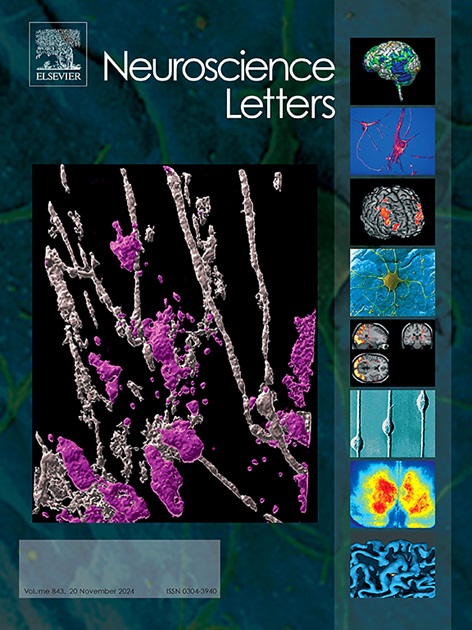NMDA current is enhanced by MβCD-induced D1-NMDA receptor perturbation in hippocampal CA1
IF 2.5
4区 医学
Q3 NEUROSCIENCES
引用次数: 0
Abstract
N-methyl-d-aspartate receptors (NMDARs) located in hippocampal CA1 are modulated by D1 receptors (D1Rs). This modulation is thought to be exerted by direct protein-protein interactions. Thus, the nearest spatial and temporal relationship amongst them, immersed in a lipid raft, seems critical in passing the signaling on to each other. However, whether this modulation is affected by disturbing lipid raft conformations is still unknown. Therefore, this work aimed to investigate changes in CA1 synaptic responses resulting from disrupting NMDARs-D1Rs interactions. Experiments were conducted on hippocampal slices obtained from 15-day-old Wistar rats. A selective D1Rs antagonist (SCH23390) was used to reduce NMDA current (NMDAc) activity, suggesting a potential influence of endogenous dopamine (DA). This finding was further supported by depleting DA in experiments including reserpine. Dopaminergic modulation of NMDAc was assessed in slices preincubated with Methyl-β-cyclodextrin (MβCD). Exposure to SCH23390 in MβCD-treated slices significantly enhanced amplitude and τ deactivation of NMDAc compared to slices treated with SCH23390 solely. These alterations were readily correlated with changes in synaptic efficacy. Moreover, CaMKII inhibitory peptide 281–309 significantly counteracted the increased synaptic response observed in SCH23390 + MβCD conditions. Together, these results support the notion that lipid rafts perturbation impedes a NMDARs-D1Rs interaction, therefore a modulatory inhibition depending on this interaction.
m β cd诱导海马CA1区D1-NMDA受体的扰动可增强NMDA电流
位于海马CA1区的n -甲基-d-天冬氨酸受体(NMDARs)受D1受体(D1Rs)调节。这种调节被认为是由直接的蛋白质-蛋白质相互作用施加的。因此,它们之间最近的空间和时间关系,沉浸在脂质筏中,似乎对相互传递信号至关重要。然而,这种调节是否受到干扰脂筏构象的影响尚不清楚。因此,这项工作旨在研究破坏NMDARs-D1Rs相互作用导致的CA1突触反应的变化。实验采用15日龄Wistar大鼠海马切片进行。使用选择性D1Rs拮抗剂(SCH23390)降低NMDA电流(NMDAc)活性,提示内源性多巴胺(DA)的潜在影响。在包括利血平在内的实验中消耗DA进一步支持了这一发现。用甲基β-环糊精(m -β cd)预孵育的薄片评估NMDAc的多巴胺能调节。与单独使用SCH23390处理的切片相比,m β cd处理的切片暴露于SCH23390显著增强了NMDAc的振幅和τ失活。这些改变很容易与突触效能的变化相关。此外,CaMKII抑制肽281-309显著抵消了SCH23390 + MβCD条件下观察到的突触反应增加。总之,这些结果支持了脂筏扰动阻碍NMDARs-D1Rs相互作用的概念,因此依赖于这种相互作用的调节抑制。
本文章由计算机程序翻译,如有差异,请以英文原文为准。
求助全文
约1分钟内获得全文
求助全文
来源期刊

Neuroscience Letters
医学-神经科学
CiteScore
5.20
自引率
0.00%
发文量
408
审稿时长
50 days
期刊介绍:
Neuroscience Letters is devoted to the rapid publication of short, high-quality papers of interest to the broad community of neuroscientists. Only papers which will make a significant addition to the literature in the field will be published. Papers in all areas of neuroscience - molecular, cellular, developmental, systems, behavioral and cognitive, as well as computational - will be considered for publication. Submission of laboratory investigations that shed light on disease mechanisms is encouraged. Special Issues, edited by Guest Editors to cover new and rapidly-moving areas, will include invited mini-reviews. Occasional mini-reviews in especially timely areas will be considered for publication, without invitation, outside of Special Issues; these un-solicited mini-reviews can be submitted without invitation but must be of very high quality. Clinical studies will also be published if they provide new information about organization or actions of the nervous system, or provide new insights into the neurobiology of disease. NSL does not publish case reports.
 求助内容:
求助内容: 应助结果提醒方式:
应助结果提醒方式:


